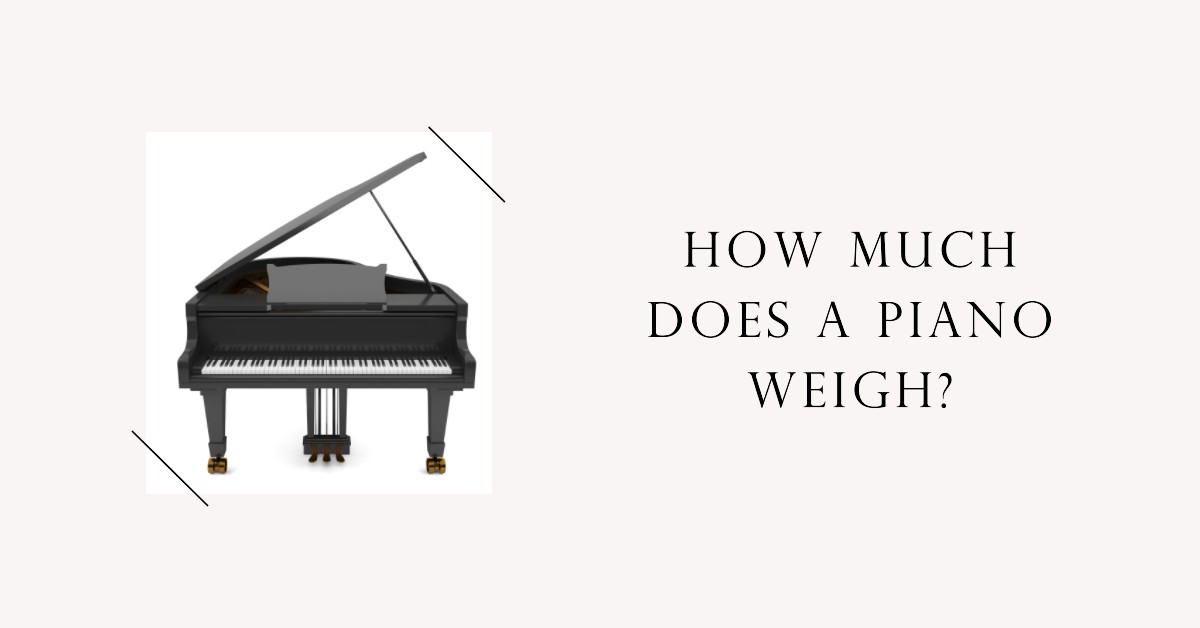Pianos are complex and finely crafted instruments that produce beautiful music. However, their intricate construction and solid materials like cast iron and wood make them incredibly heavy. So how much does a piano like a Steinway or Yamaha actually weigh? The answer depends on the type and size of piano.
Types of Pianos and Their Average Weights
There are two main categories of pianos – upright pianos and grand pianos. Within each category, there are several sizes that vary in height and length, which affects their weight in pounds or kilograms. Here are the different types and their typical weight ranges:
Upright Pianos
Upright pianos are the most common type found in homes. They have a vertical orientation with the strings and soundboard standing upright inside.
- Spinet pianos: 36-40 inches tall, 200-400 lbs
- Console pianos: 40-43 inches tall, 350-450 lbs
- Studio pianos: 44-48 inches tall, 400-500 lbs
- Large upright pianos: 48-60 inches tall, 500-1000 lbs
The smallest upright pianos like spinets can weigh as little as 200 lbs. Full-size uprights are much heavier, commonly weighing 500-600 lbs on average. The tallest uprights reach up to 1000 lbs.
Grand Pianos
Grand pianos have a horizontal orientation with the strings lying flat inside. They take up more floor space but produce louder, richer sound.
- Baby grand pianos: 5-5.5 feet long, 500-650 lbs
- Medium grand pianos: 5.5-6 feet long, 600 lbs
- Parlor grand pianos: 6-7 feet long, 700-750 lbs
- Concert grand pianos: Over 9 feet long, 900-1500 lbs
Baby grand pianos offer a compromise between size and sound quality, weighing 500-650 lbs. Large concert grands like Steinway or Mason & Hamlin are the heaviest pianos, ranging from 900-1500 lbs.
What Makes a Piano So Heavy?
Pianos are extremely heavy due to their sturdy construction and the materials used:
Materials
- Cast iron frame: The plate or harp is made of dense cast iron to withstand string tension. It makes up 70% of a piano’s weight.
- Wooden exterior: Thick, solid wood is used for the cabinet, rim, lid, legs, etc. Hardwoods like maple add weight.
- Steel strings: Between 220-240 high-tensile steel strings put tons of pressure on the frame.
Internal Components
- Soundboard: Spruce soundboards amplify the strings’ vibrations and are large & heavy.
- Pinblock: This block anchors the strings and is made of dense hardwood.
- Keys: 88 keys made of wood with felt, leather, or synthetic coverings.
- Hammers: The felt hammers that strike the strings are heavy in aggregate.
- Pedals: Made from brass or other metals, the pedals like the damper have significant weight.
All these elements add up to make even a small piano very heavy!
Considerations When Moving a Piano
Moving a piano poses unique challenges due to its size, weight, and delicate nature:
- Challenging weight: Hundreds of pounds of weight make pianos difficult for piano movers to lift and maneuver.
- Awkward shape: The irregular shape is hard to grip and requires special handling by professionals.
- Risk of damage: Dropping or jostling a piano can damage its finely tuned strings and moving parts.
- Professional assistance recommended: Piano movers have special equipment like dollies and straps and handle the job with great care.
Improper moving by amateurs can ruin an expensive piano, so hiring professional piano movers is usually worth the cost for piano owners.
Moving a Piano Yourself
While professional piano movers are ideal, you can move an upright piano yourself if you take precautions:

Moving Upright Pianos
- Remove detachable legs and pedals to reduce weight.
- Carefully tip the piano on its side and slide moving blankets underneath.
- Use thick moving blankets or pads to prevent scratches.
- Secure blankets in place with tape or furniture straps.
- Carefully tilt the piano onto a sturdy dolly.
- Wheel the secured piano to the new location, avoiding stairs if possible.
- Have at least 2-3 strong helpers. Go slowly!
Transporting Baby Grand Pianos
- Remove the legs and lyre.
- Pad the piano’s rim and underside to prevent scratches.
- Use moving straps to secure padding in place.
- Carefully lift the piano onto a piano board or thick moving blanket.
- Use at least four strong people to move the board.
- Tilt the board onto a dolly and wheel to the new spot.
Take precautions like measuring doorways and removing doors if needed. Go up and down stairs slowly and safely. Consider hiring a professional piano tuner for a post-move tuning to adjust any shifting.
Costs of Professional Piano Moving
Hiring professional piano movers is the safest option but comes at a cost:
- Local moves: $200-$500 for short local moves between homes or studios.
- Long distance: $800-$1500+ for longer moves to new cities requiring trucking.
- Stairs: $50-$100 for carefully moving up or down flights of stairs.
- Tuning: $100+ for post-move tuning by a piano technician to adjust any shifting.
- Additional services: Packing, storage, and hoisting with pulleys add more costs.
Rates vary by mover and location. Moving a concert grand piano or antique piano costs more due to extra care and handling required by professionals. Despite the costs, they prevent damage and headaches for piano owners.
Conclusion
A piano’s weight depends on its size and construction but ranges widely from 200-1500 lbs on average. Small uprights weigh a few hundred pounds while concert grands tip the scales at 1500+ lbs. Thick wood, cast iron plates, and steel strings account for the heft. Special handling is required to move pianos safely, so piano owners, schools, churches, and universities commonly hire professional piano movers.
Understanding exactly how much a piano weighs before a move allows you to plan and budget accordingly. With the right preparations and equipment, even the heaviest grand piano can be moved to its new home or concert hall intact.
FAQs
Q: How much does a piano weigh?
A: The weight of a piano can vary depending on its type and size. A standard upright piano weighs around 300-500 pounds (136-227 kilograms), while a grand piano can weigh anywhere from 500 to over 1,500 pounds (227-680 kilograms).
Q: How much does a grand piano weigh?
A: The weight of a grand piano can range from 500 to over 1,500 pounds (227-680 kilograms). The exact weight will vary depending on the size and make of the piano.
Q: How much does an upright piano weigh?
A: An upright piano typically weighs around 300-500 pounds (136-227 kilograms). However, the weight can vary depending on the size and model of the upright piano.
Q: How much does a digital piano weigh?
A: Digital pianos are generally lighter than acoustic pianos. The weight of a digital piano can range from 20 to 100 pounds (9-45 kilograms), depending on the model and features.
Q: How much does it cost to move a piano?
A: The cost to move a piano can vary depending on several factors, including the distance of the move, the type of piano, and any additional services required. On average, professional piano movers may charge between $200 and $1,000 for local moves, and the cost can increase for long-distance moves or if stairs or other challenging factors are involved.
Q: How much does an average piano weigh?
A: An average piano, whether it is an upright or grand, typically weighs between 300 to 1,500 pounds (136-680 kilograms). The weight will depend on the specific make and model of the piano.
Q: How to move a piano without professional movers?
A: Moving a piano without professional movers can be challenging and risky. It is recommended to hire specialist piano movers who have the expertise and equipment to safely move a piano.
Q: How much does a spinet piano weigh?
A: A spinet piano is a type of vertical piano that is smaller in size compared to other upright pianos. The weight of a spinet piano can range from 300 to 500 pounds (136-227 kilograms).
Q: How much does a baby grand piano weigh on average?
A: On average, a baby grand piano weighs around 500 to 800 pounds (227-363 kilograms). The exact weight may vary depending on the make and model.
Q: How much does a professional grand piano weigh?
A: A professional grand piano, also known as a concert grand piano, can weigh over 1,000 pounds (453 kilograms). These pianos are larger in size and are designed for professional performances.





